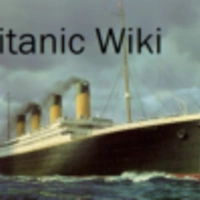Benjamin Guggenheim was an American millionaire and businessman. He was a passenger on the RMS Titanic and famously died aboard the ship as it sank.
Biography[]
Early life[]
Benjamin was born in Philadelphia, Pennsylvania, USA, the fifth of seven sons of the wealthy mining magnate Meyer Guggenheim (1828–1904) and Barbara Myers (1834 – 1900). In 1894, he married Florette Seligman (1870 – 1937),[1] daughter of James Seligman, a senior partner in the firm J & W Seligman, and Rosa Seligman née Content. They had three daughters: Benita Rosalind Guggenheim (1895 – 1927), Marguerite "Peggy" Guggenheim (1898 – 1979) and Barbara Hazel Guggenheim (1903 – 1995).
While Guggenheim inherited a great deal of money from his father, he did not inherit his father's business acumen. His inheritance dwindled considerably from a number of poor investments. He grew distant from his wife and, ostensibly for business reasons, was frequently away from their New York City home. He maintained an apartment in Paris, France.[2]
Aboard the Titanic[]
On April 10, Guggenheim was in Cherbourg where he boarded the RMS Titanic in the late evening. He was accompanied by his mistress, a French singer named Léontine Aubart (1887 – 1964). Also with him on Titanic were his valet Victor Giglio (1888 – 1912); his chauffeur René Pernot (1872 – 1912) and Madame Aubart's maid, Emma Sägesser (1887–1964). His ticket was number 17593 and cost £79 4s (other sources give the price as £56 18s 7d). He and Giglio occupied stateroom B-82 while Aubart and Sägesser occupied cabin B-35. Pernot occupied an unknown cabin in Second Class.
The Sinking[]
On the late night of April 14, Guggenheim and Giglio slept through the Titanic's encounter with the iceberg only to be awakened just after midnight on April 15, by Aubart and Sägesser, who had felt the collision. Sägesser later quoted Giglio as saying, "Never mind, icebergs! What is an iceberg?" Guggenheim was persuaded to awaken and dress; Bedroom Steward Henry Samuel Etches helped him on with a lifebelt and a heavy sweater before sending him, Giglio, and the two ladies up to the Boat Deck.
As Aubart and Sägesser reluctantly entered lifeboat 9, Guggenheim spoke to the maid in German, saying, "We will soon see each other again! It's just a repair. Tomorrow the Titanic will go on again." Realizing that the situation was much more serious than he had implied, as well as realizing he was not going to be rescued, he then returned to his cabin with Giglio and the two men changed into evening wear. The two were seen heading into the Grand Staircase closing the door behind them. He was heard to remark, "We've dressed up in our best and are prepared to go down like gentlemen." He also gave a survivor a message saying, "If anything should happen to me, tell my wife in New York I've done my best in doing my duty." [3] Guggenheim and his valet were last seen seated in deck chairs in the foyer of the Grand Staircase sipping brandy and smoking cigars. Both men went down with the ship. Their bodies, if recovered, were never identified. Guggenheim's chauffeur, René Pernot, was also lost in the disaster.
Portrayals[]
Benjamin Guggenheim was one of the most prominent American victims of the disaster. As such, he has been portrayed in the numerous movies, television series and a Broadway show depicting the sinking.
'Titanic' (1953)[]
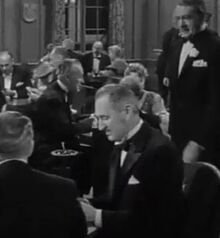
Benjamin Guggenheim play card with Maude Young and Isidor Straus in the 1953 Titanic
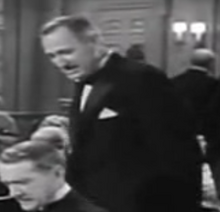
Benjamin Guggenheim in Titanic (1953)
Camillo Guercio portrayed Benjamin Guggenheim in the movie 'Titanic', produced by Fox in 1953. He only appears in a few scenes, and his role was uncredited.
'A Night to Remember'(1958)[]
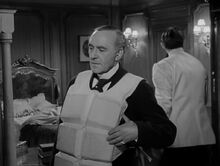
Benjamin Guggenheim wearing his lifebelt in A Night to Remember (1958)
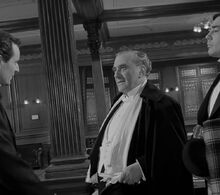
Benjamin Guggenheim in "A Night to Remember' (1958)
Harold Goldblatt portrayed Benjamin Guggenheim in A Night to Remember (1958) He appears with his Valet, Victor Giglio during the sinking, he say "We have dressed in our best, and are prepared to go down like gentlemen" to Thomas Andrews.
'S.O.S. Titanic' (1979)[]
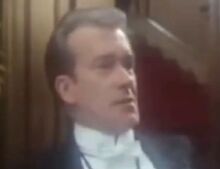
John Moffat as Benjamin Guggenheim in 'S.O.S. Titanic' (1979)
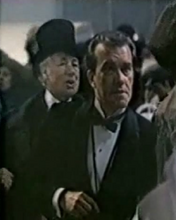
Benjamin Guggenheim in 'S.O.S. Titanic' (1979)
John Moffat portrayed Benjamin Guggenheim in S.O.S. Titanic (1979).
1996 Miniseries 'Titanic'[]
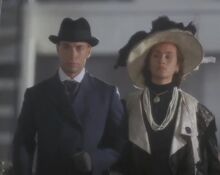
Benjamim Guggenheim with Leontine Aubart in 'Titanic' (1996)
Benjamin Guggenheim was portrayed by an uncredited actor in the 1996 Miniseries 'Titanic', He only appear in episode 1 with Léontine Aubart and was introduced by Hazel Foley to Isabella Paradine. Originally, he also appears in part 2, which showed the moments between him and his mistress.
'Titanic: The Musical' (1997)[]

Joseph Kolinskin as Benjamin Guggenheim in the 1997 broadway musical.
Joseph Kolinski played Benjamin Guggenheim in the 1997 production of Broadway.
Titanic (1997)[]

Benjamin Guggenheim with Leontine Aubart in 'Titanic (1997)
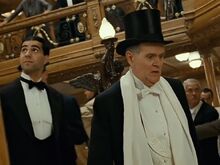
Benjamin Guggenheim with his valet, Victor Giglio in the Grand Staircase around 2:00 A.M.
Michael Esign portrayed Benjamin Guggenheim in 'Titanic' (1997). Guggenheim is depicted in the Grand Staircase, refusing a lifebelt from a steward and staying near the Grand Staircase as it floods. He is last seen staring in horror with his valet at the rushing water coming up to meet them.
2012 Miniseries 'Titanic'[]
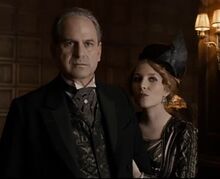
Benjamin Guggenheim with Leontine Aubart in 'Titanic' (2012)
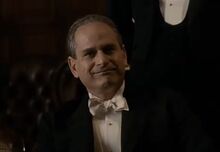
David Eisner as Benjamin Guggenheim in the 2012 Miniseries 'Titanic'
David Eisner portrayed Benjamin Guggenheim in the 2012 Miniseries 'Titanic', He appears in 3 of the 4 episodes.
Other references[]
Guggenheim is possibly the inspiration for the character in the Italian animated series Huntik: Secrets & Seekers, the character who shares the same name.
In the novel Last Tango in Aberystwyth by Malcolm Pryce, Ben Guggenheim's concern for others before himself as the Titanic is sinking is used as a moral compass.
| |||||||||||
References[]
- ↑ Guggenheim-Seligman : New York Times (1894) – October 25, 1894
- ↑ "Benjamin Guggenheim". biography.com. http://www.biography.com/people/benjamin-guggenheim-283816. Retrieved February 16, 2012.
- ↑ "New York Times, 20th April 1912 (reproduced via Encylopedia Titanica". encyclopedia-titanica.org. http://www.encyclopedia-titanica.org/guggenheim-dying-sent-wife-message.html. Retrieved April 17, 2012.
